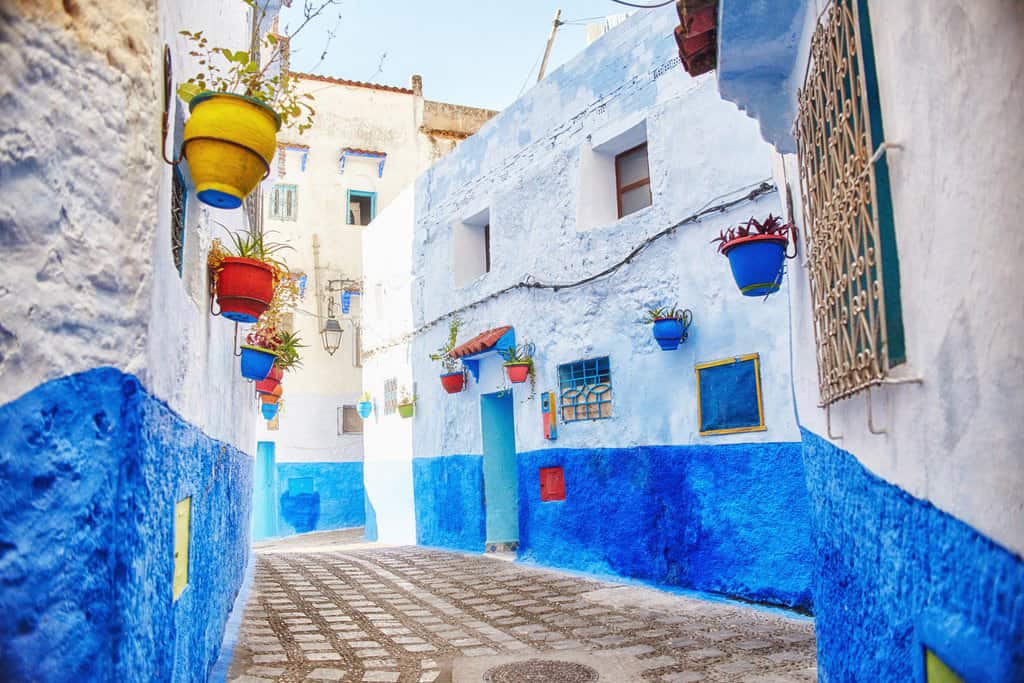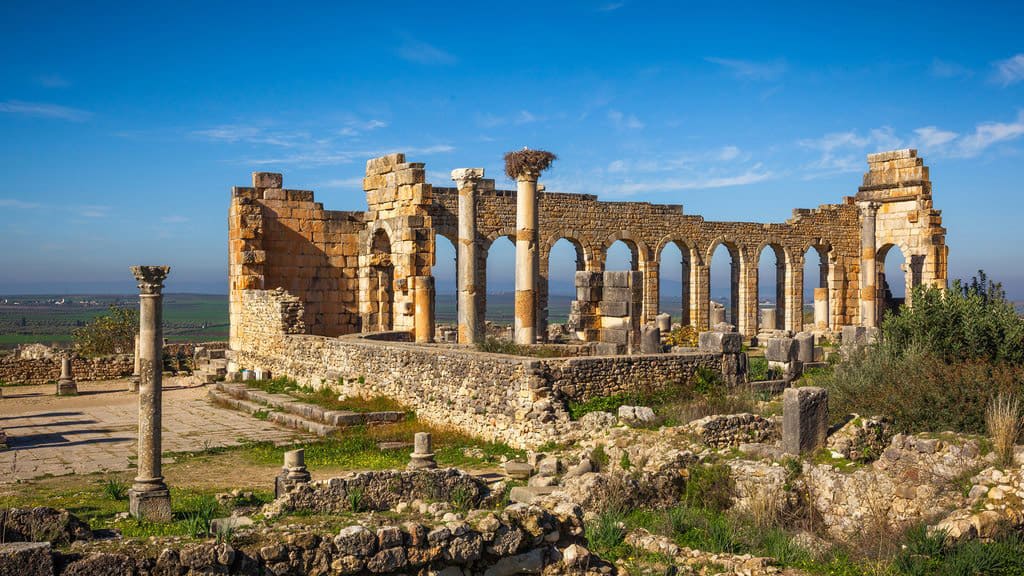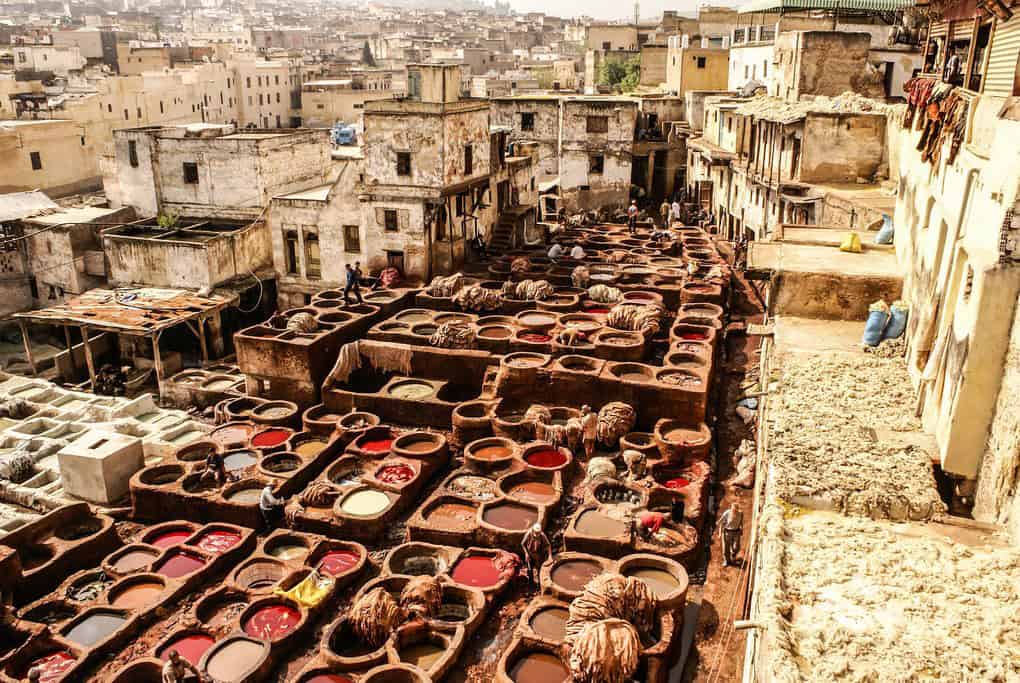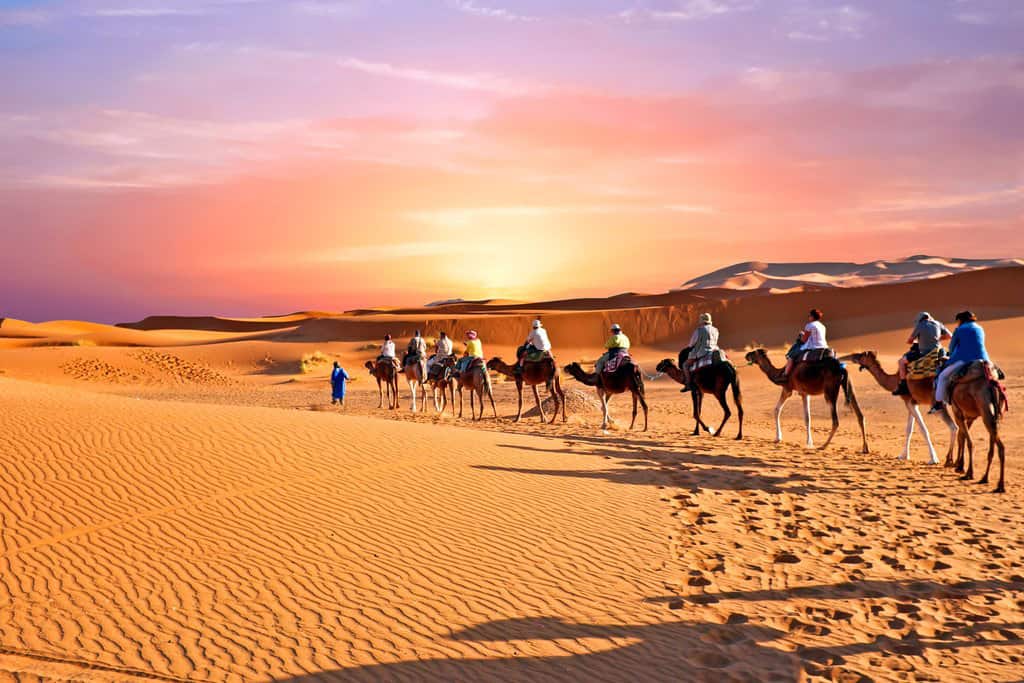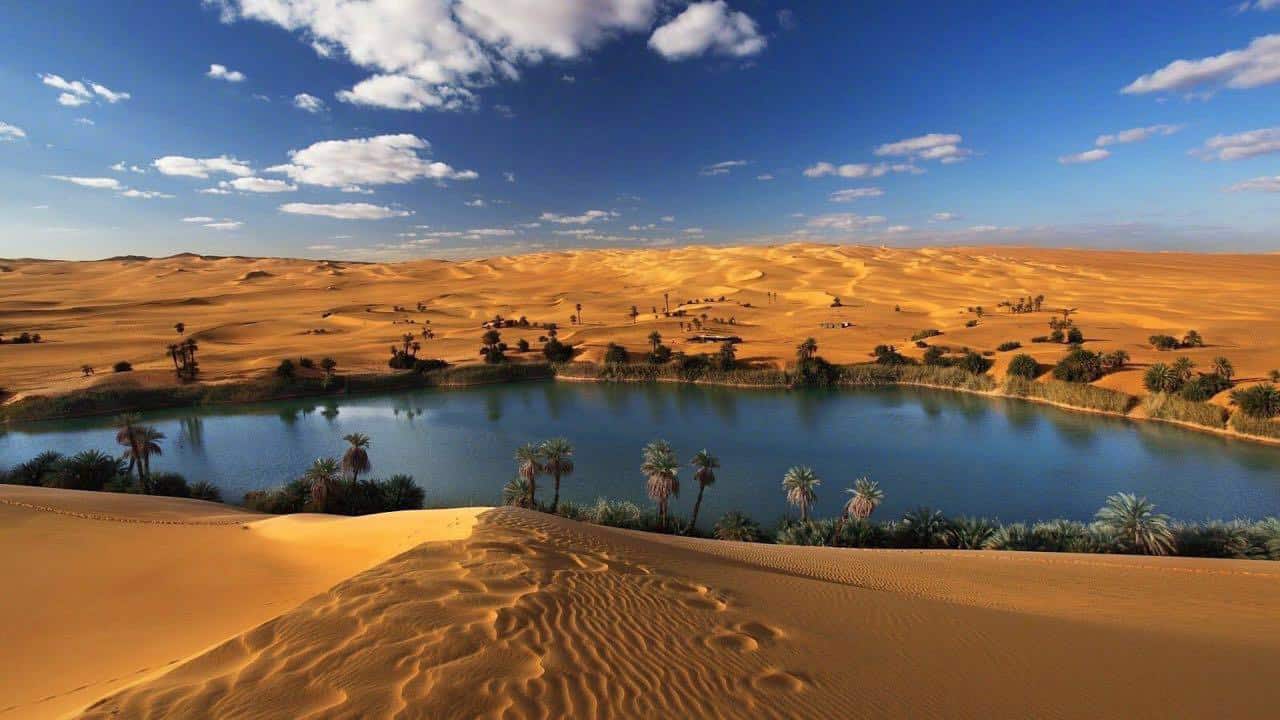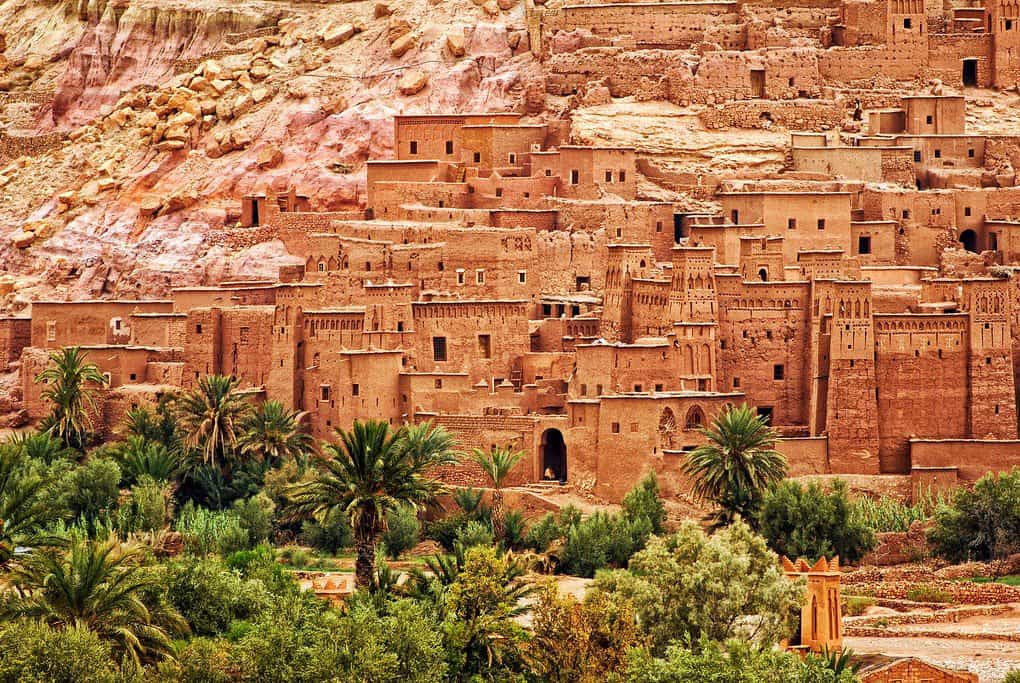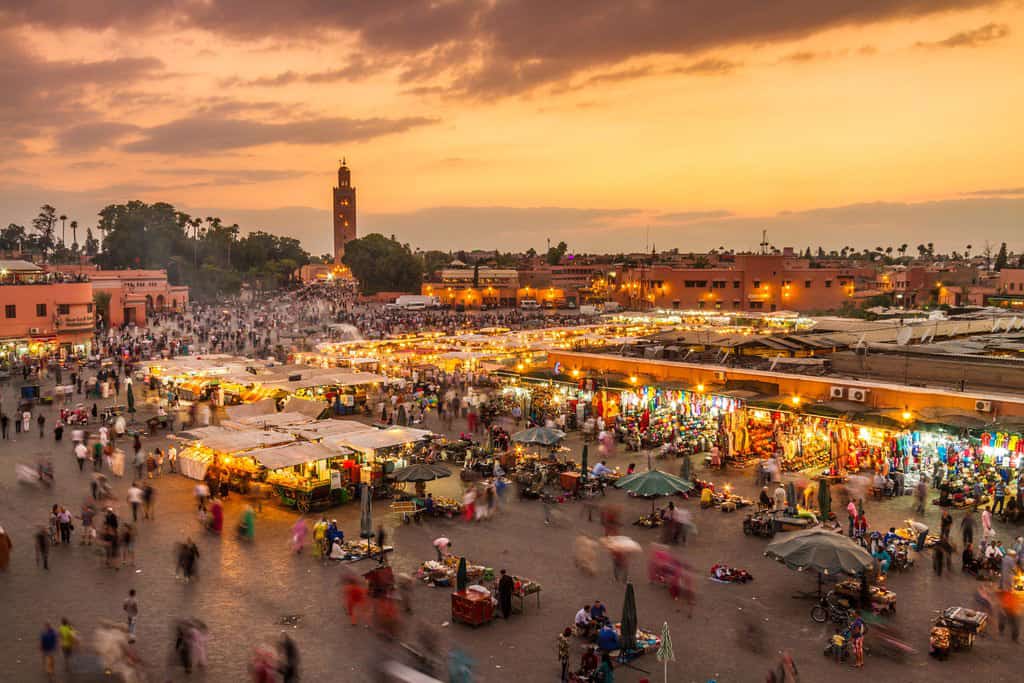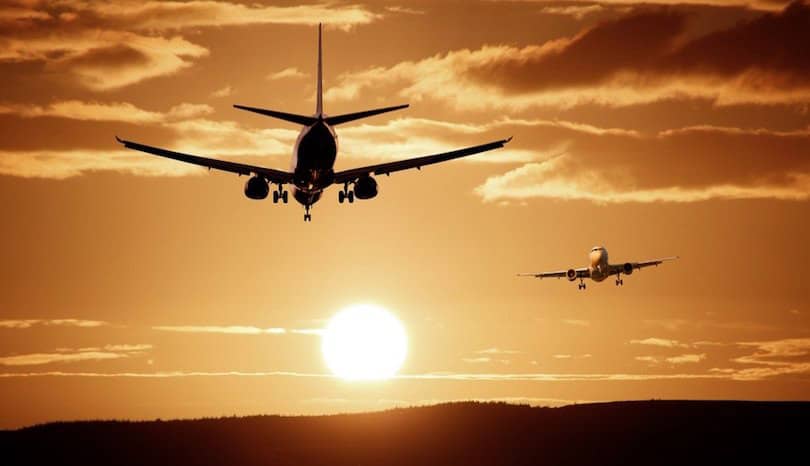Tangier to Marrakech via the Sahara Desert
From Tangier
8 Days
Overview
Enjoy a perfect mix of culture, history, and adventure in just over a week in Morocco. Starting in the Tangier to Sahara desert, wander the blue-painted streets of Chefchaouen, navigate the maze-like alleyways of Fes, and ride a camel into the shifting sands of the Sahara. Finish your trip in Marrakech among museums, medieval inns, and the many souks where you can pick up an authentic souvenir before heading home.
Details & Itinerary
Day 1 –Tangier to Chefchaouen
Welcome to Tangier—the gateway between Europe and Africa. Located close to the south of Spain, visit the medina (old quarter), a café in the hip Zoco Chico square, or take a paseo to enjoy a stroll along the promenade. Or, travel straight on to the blue-hued city of Chefchaouen in the Rif Mountains. Enjoy the scenic route, stopping along the way to hike to the Cascades d’Akchour (Waterfalls of Akchour). Chefchaoen offers endless winding narrow streets and picturesque buildings. Find Plaza Outa el Hammam for a restaurant or café and enjoy a meal as you people-watch.
Though non-Muslims are not permitted to enter, the Grand Mosque is still worth a visit. From there, explore the nearby kasbah (old fortification) and tour the garden, museum, and some of the old prison cells. Follow a path outside the city walls to Hotel Atlas and climb to the rooftop to enjoy a panoramic view of the Blue City. For the slightly more athletic, follow the street east to pass over the Ras el Ma Spring and ascend the path (20-30 minutes) until you reach the abandoned white Spanish Mosque. Enjoy one last view over Chefchaouen as the sun sets behind the mountains.
Day 2 –Roman ruins at Volubilis – Meknes – Fes
Rise early to snap photos of the people-less streets before leaving for Fes. Stop along the way at the UNESCO-protected Volubilis ruins—the Roman’s farthest reach in Africa. Wander the complex, exploring merchant homes with still-intact heating systems, temples, and many mosaics in situ. Continue to the smaller, less busy version of Fes, Meknes, for an introduction to your first historic imperial city. The two main points of interest are the Ville Impériale (Imperial City) and the Medina. Be sure to visit the Bab al-Mansour gate, the Mausoleum of Moulay Ismail, and the Royal Stables.
Continue east to your second imperial city, Fes. With its impressively large (and somewhat confusing) old medina, Fes is a city worth getting lost in. Before venturing into the medina, drive up the hill to take the time to visit the Merenid Tombs located just north of the city and enjoy the all-encompassing view of historic Fes and the surrounding area. Descend the hill and find your way to your riad (a traditional Moroccan house with an interior garden) where you can enjoy a delicious meal and relax for the evening.
Day 3 –Exploring Fes
Fes is the oldest of the four Imperial cities in Morocco and perhaps the most interesting and exciting to explore. It has the most complete medina in the Arab world and is relatively untouched since it was founded over 1,000 years ago. Often considered the country’s cultural capital, it comprises three parts: two medina quarters, Fes el Bali and Fes el Jdid, and the more modern, French colonial influenced, Ville Nouvelle. Meet your guide and spend a half day learning about the history and culture as you navigate the narrow streets of the medinas.
Start in Fes el Bali at the Bab Boujeloud gate and enter the main thoroughfare of Talâa Kebira. Notice the Spanish and Tunisian-influenced architecture as you make your way past shops and souks (markets). Visit the Chouara Tannery and watch workers using centuries-old techniques. Next, admire the intricate zellij tilework of the 14th-century Al Attarine madrasa before heading to the Mellah (old Jewish quarter and cemetery) in Fes el Jdid. If there’s time, visit Ville Nouvelle for a dramatic change in architecture.
Day 4 –Middle Atlas – Erfoud, Merzouga, and the Sahara
Start your day bright and early and travel south toward Merzouga. Along the way, you will climb up and over the Col du Zad pass (7,146 feet or 2,178 m) through the cedar forests of the Middle Atlas mountains. Enjoy sightings of the local Barbary Macaque monkeys before stopping for lunch in Midelt (the ‘apple city’), and relishing the nearby Moulouya River. Continue over the Tizi n’Talremt pass and into the Ziz Valley, known for its hidden oases and palm tree clusters. Along the road, you will see many fortified houses known as ksars—built to protect precious wares, including gold, salt, and spices.
Continue to Erfoud, known for its date festival and fossil mining. Here you can visit a local collective to learn more about the process and meet some local artisans. Continue to Erg Chebbi, an extensive sea of dunes covering an area of 13.5 square miles (35 square km). Never stationary, the massive dunes shift and travel depending on the changing wind. Upon reaching Merzouga, climb atop your camel to ride through the dunes to your already-prepared-for-you camp. Trek up a nearby dune to watch the sunset before returning to camp for a delicious dinner, relaxing by the campfire.
Day 5 –Desert towns, lush oases, and film worthy landscapes
Catch the sunrise before renting a sandboard to test your skills. Leave the dunes and head to Khemliya to experience a traditional Saharan village—its people originally from Mali. Continue west to pass through a dramatic gate into Rissani. A market town, Rissani holds a livestock auction and is home to a “donkey parking lot,” a site worth (hearing) about and experiencing! Make your way to the desert town of Tinerhir before reaching the 984-foot (300 m) deep Todra Gorge. You will have time to explore the gorge and relax in the cool water of the shallow Todra River.
Travel through the Valley of a Thousand Kasbahs. Though many are now in disrepair, local families still live in some of them. You may even come across nomads herding their animals. Head west to Kela’a M’gouna. Known for its Festival des Roses, here you can see extensively cultivated farmland bordered with fragrant rose bushes. Continue west to Ouarzazate, a gateway to the Sahara Desert made popular by the film industry. Join a studio tour and discover how the nearby desert landscapes have been featured in many films.
Day 6- Aït Benhaddou Kasbah – Tizi n’Tichka Pass – Marrakech
Rise early and continue to Morocco’s most famous kasbah and a UNESCO World Heritage site, Aït Benhaddou. It is estimated the old Ksar (a walled town) dates from the 11th century when it held an important position along the trans-Saharan trade route. Stop and explore the narrow streets and passageways of this traditional mud-brick city. From there, travel the winding road over the High Atlas mountains, noting the highest peak, Mount Toubkal (13,671 feet or 4,167 m). Stop near the top of the Tizi n’Tichka Pass (7,415 feet or 2,260 m) to admire the view over the mountain range.
Stop at an Argan Oil Cooperative in Taddert to learn how olives are processed, before making your descent down the High Atlas and into the changing scenery. Upon arriving in the Red City of Marrakech, settle into your hotel and spend the rest of the afternoon as you like. Orient yourself around Marrakech’s main square, Jemaa el-Fna, and visit the 12th-century Koutoubia Mosque to its west. At 253 feet (77 m) the minaret is hard to miss. Wander the attached gardens, dotted with fountains, pools, flowers, and palm trees, perfect for a late afternoon stroll when the late-day sun glows on the minaret.
Return to Jemaa el-Fna—Africa’s busiest square—and discover the lively activity: musicians, performers, snake charmers, and bustling stalls. Grab something to eat or choose a nearby café and enjoy the show.
Day 7 –Marrakech
Nicknamed the “Red City” for its 1000-year-old red sandstone city walls and buildings, Marrakech is a major economic center. Marrakech has Berber rather than Arab roots and was once an important trading capital for tribes of the Atlas mountains. For a unique way to tour the medina, board a calèche (French for horse-drawn carriage) and begin to adjust to your surroundings. Notice the founders—medieval inns that provided merchants and travelers with shelter and supplies. Today some have been converted into residences or large shopping areas and workshops that you can explore.
Indulge your senses as you explore the complicated labyrinth of souks, tucked behind ordinary restaurants and shops. Check out Souk el Attarin, Souk Chouari, and Souk Smata for a selection of spices, woodwork, and babouche (traditional Moroccan slippers). Visit Souk des Tenturier or the dyers’ souk to see how cloth and yarn are dyed using traditional methods. Next, admire the fine example of Moroccan Islamic architecture of the Ben Youssef Madrasa, a 16th-century Koranic school, and note the ornate detail of its interior: carved cedar ceilings, sculpted plaster, and zellij tiling.
Day 8 –Departure from Marrakech
Depending on your flight details, you may explore the Kasbah area south of Jemaa el-Fna. Once there, check out the Saadian Tombs and discover the 500-year-old craftsmanship that went into its construction. Visit the sunken gardens of the 17th-century El Badi Palace as you work your way through the Mellah and to the 19th-century Bahia Palace. If there’s time, you may wish to check out the Dar Di Said Museum (also known as the Museum of Moroccan Arts) to see exhibits of clothing, antiques, jewelry, and beautifully carved Hispano-Moorish decorations of carved cedar wood.
Tour Itinerary
Day 1–Tangier to Chefchaouen.
Day 2 – Roman ruins at Volubilis – Meknes – Fes.
Day 3 – –Exploring Fes.
Day 4 – Middle Atlas – Erfoud, Merzouga, and the Sahara.
Day 5– Desert towns, lush oases, and film worthy landscapes.
Day 6 – Aït Benhaddou Kasbah – Tizi n’Tichka Pass – Marrakech.
Day 7– Marrakech.
Day 8 – Departure from Marrakech.
What’s Included
Planning and quality control by seasoned travel leaders
Knowledgeable Guides (Multi-lingual), special lectures, and insightful meetings
Entrance Fees to Historic Monuments
All Transfers-even individual airport transfers, when required.
Luggage Handling-at all hotels, airport, etc.
Air-Conditioned, comfortable, and luxurious vehicles depending on your choice (4*4, Mini-bus…).
Nights at the top range hotels, Riads, Kasbahs, and Bivouacs.
Elegant Meals (Breakfast daily, and usually either Dinner).
All details are handled by reliable, experienced Tour Leaders.
Outstanding value and convenience.
No hidden add-ons or markup.
What’s Excluded
Lunchs
Tips
Travel insurance charges
Travel Advices
_
_
Best time to visit Morocco
The climate in Morocco varies wildly according to the season and area of travel. In the lowlands, the cooler months from October to April are popular among visitors. This time of year is pleasantly warm to hot (around 30°C) during the day and cool to cold (around 15°C) at night. Winter in the higher regions often brings snow and can therefore get seriously cold, particularly at night. Tourists flock to the coastline from June to September for fun in the sun, with warm mostly rain-free days. Further inland it can get hot and rain is rare, which makes the best times to travel March to June and September to December.
Morocco Culture & Customs
Morocco's culture has developed over centuries of influence from far and wide. Contemporary Morocco is a fascinating mix of Berber, Mediterranean, Andalucian, and African traditions, which are present in the cuisine, clothing, music, language, customs, and lifestyle. As an Islamic country, most Moroccans are Muslim; however, there are small populations of people who practice Judaism and Christianity. Classic examples of Islamic architecture can be observed all throughout the country and tenets of the Islamic religion are carried out in the customs and lives of the people. The 'Call to Prayer' can be heard five times a day, women are expected to dress modestly and alcohol isn't drunk by most of the population.
Most of Moroccan society can be considered traditional, with respect for elders, connection to family, and giving alms to the poor hallmarks of everyday life for many Moroccans. Hospitality is another important element of society, with warmly welcoming people into your home a time-honored tradition and social responsibility that dates back centuries.
Vegetarian and Vegan Options in Morocco ?
Much of Morocco's cuisine revolves around meat, but vegetables are an important staple and a crucial ingredient in many dishes of the Maghreb. Your diet can consist of more than just flatbread and hummus – trust us. Keep an eye out for vegetable-based tagines and couscous, the renowned Zaalouk (a smokey eggplant and tomato salad), vegetable Briouats (triangular-filled pastries), and cinnamon oranges. Vegan options are slightly more limited, as many of the pieces of bread and couscous dishes have butter added to them, but your best bet is to enquire if yours can be made using oil instead. Otherwise, it's easy to dine well on varied vege offerings in Morocco.
Frequently Asked Questions
Morocco Tour Add-ons
Choose Morocco Culture Travel as your trusted travel partner from Tangier to Marrakech! Enjoy a safe and outstanding experience! Whether you choose your private tours from Tangier, a Marrakech Sahara desert tour, or any other experience in Morocco, we will offer you a unique blend of culture, adventure, and new experiences!
You can also check our Marrakech to Fes Sahara tour!



